Project Summary
The Nine Mile Creek Watershed District and the City of Bloomington are implementing a multi-stepped approach to improve the health of Normandale Lake—a shallow lake with a large, urban watershed. To date, projects include a lake drawdown (2018-2019), aluminum (alum) treatment (2019), herbicide treatments (2020-2024), and carp management.
About Normandale Lake
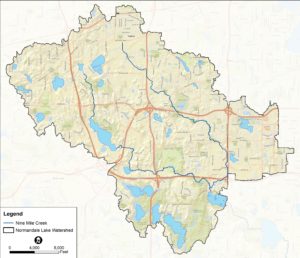
Normandale Lake was created as part of a flood control project in the late 1970s by the District and City of Bloomington in an area of natural marsh land. A permit for the construction of the lake was issued by the Army Corps of Engineers, which limits some management options for Normandale Lake, such as aquatic vegetation harvesting and dredging on the western half of the lake. Normandale Lake is a shallow lake (three-foot average depth). This means aquatic plants naturally grow throughout the lake. A robust, native aquatic plant population is part of a healthy shallow lake dynamic.
Normandale Lake receives water from a drainage area of over 34 square miles, including water from six different cities. The water flows into the lake through Nine Mile Creek and stormwater pipes. Nutrients, such as phosphorus and nitrogen, from sources such as grass clippings, tree litter, lawn fertilizer, and sediment from paved surfaces and erosion travels with this water. This is called external nutrient loading. Internal loading is when phosphorus is released from lake bottom sediments. Excess nutrients can fuel algae growth in the lake.
Normandale Lake is not currently on the state’s impaired waters list but does frequently have phosphorus levels that exceed state standards (>60 µg/L). Historically, Normandale Lake has met the chlorophyll-a and Secchi disc depth standards for shallow lakes.
Project Goals
Improve the water quality and the ecological health of Normandale Lake by:
- Controlling invasive curly-leaf pondweed
- Improving the diversity of native plant species
- Reducing phosphorous
- Controlling the invasive carp population
Project Details
The Normandale Lake Improvement Project has involved multiple lake management strategies to achieve project goals.
Lake Drawdown
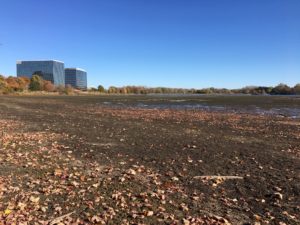
Curly-leaf pondweed is an invasive plant that out-competes native aquatic plant communities. The plant can also contribute to high phosphorous levels in a lake when it dies off and decays mid-summer. A drawdown is one way to control curly-leaf pondweed. Curly-leaf pondweed primarily reproduces through vegetative propagules called turions. The plant produces turions in late spring, the turions remain dormant in the sediment through the summer, and then germinate under cooler water conditions in the fall. A winter freeze of the lake sediment bed (while the lake is empty of water) can kill the turions, thus stopping the curly-leaf pondweed’s reproductive cycle.
How did we drawdown the lake?
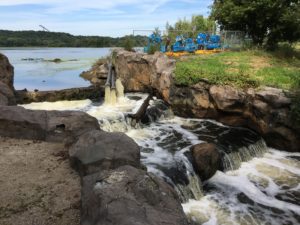
The District used temporary pumps and an existing bypass pipe in late-summer 2018 to drain the lake. Once the lake was partially drained, the District installed a larger, permanent bypass pipe to maintain the lake drawdown without pumping. When open, the pipe conveyed water from the lake, under the embankment and directly into Nine Mile Creek downstream of the existing outlet. In March 2019, following the drawdown and winter freeze of the lake bottom sediment, the bypass pipes were closed and the lake quickly refilled with water.
Curly-leaf Pondweed Herbicide Treatment
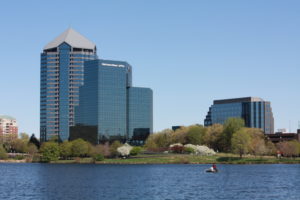
The lake drawdown decreased the amount of curly-leaf pondweed in the lake. Follow-up herbicide treatments were planned as part of the project to manage any curly-leaf pondweed that remained following the drawdown. The District assesses the need for an herbicide treatment yearly, based on plant surveys. Current project plans include up to five years of treatment, after which the effectiveness and long-term sustainability of the curly-leaf pondweed management strategy will be re-evaluated. Partial lake herbicide treatments have occurred from 2020-2024.
How does an herbicide treatment work?
The District conducts an aquatic plant survey in the spring to assess the need for an herbicide treatment. Following this, the District obtains a Minnesota Department of Natural Resources permit. Then a licensed contractor applies an herbicide called diquat (for partial-lake treatments) in areas that contain curly-leaf pondweed. Herbicide treatments are done in early spring when the water temperature in the lake is generally between 50-60o F. This is when the herbicide is most effective and limits damage to native plants, which start growing later than curly-leaf pondweed. Lake monitoring and a fall plant survey are conducted following the herbicide treatment.
Herbicide Treatment Resources:
Lake Vegetation Management Plan (LVMP)_Normandale Lake (PDF)
Alum Treatment
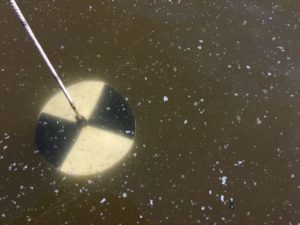
Aluminum sulfate treatments help control internal phosphorous loading in lakes, reducing the phosphorus available to fuel algae growth. The Normandale Lake alum treatment was conducted in 2019, after the lake refilled from the drawdown.
How does an alum treatment work?
Trained contractors apply alum using specialized equipment; this equipment ensures the precise placement of the material in the lake. On contact with the water, the liquid alum forms a fluffy aluminum hydroxide precipitate called floc. Aluminum hydroxide (the main ingredient of common antacids like Maalox) binds with the phosphorus to form a compound that does not dissolve in water. The bound phosphorus can no longer fuel algae growth. As the floc settles to the bottom, it removes phosphorus and particles from the water, leaving the lake clearer.
Carp Management
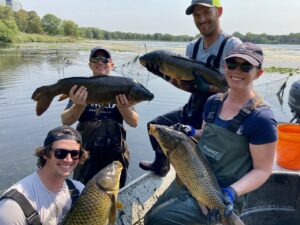
Carp are an invasive species of fish. They stir up lake bottom sediments while feeding which reduces water clarity and releases phosphorus. They also uproot aquatic vegetation, destroying habitat for waterfowl and aquatic communities. A 2018 fish survey indicated that carp were at an unhealthy level in Normandale Lake. A follow-up fish survey in 2019 found many young of the year carp in the lake, meaning the carp had reproduced after the drawdown. Tracking information shows carp leaving Normandale Lake, indicating that carp do use areas outside of Normandale Lake as nurseries.
Since 2020, the District has been working to manage carp population levels in Normandale Lake using box nets. A box net is a square net with mesh bottom and mesh sides lined with weights around each side causing it to lay flat on the bottom of the lake. Carp are trained to aggregate in the area of the box net with cracked corn (Bajer et al. 2010). The carp are then selectively and effectively removed using the box nets at the baited sites. Since 2020, over 7,500 carp have been removed from Normandale Lake.
Learn more about carp management at Normandale Lake by watching this YouTube video:
Fisheries Management Resources:
Integrated Pest Management Plan for Common Carp in Normandale Lake_1/26/23
Normandale Lake 2021 Carp Management Report (PDF)
Normandale Lake 2020 Fisheries Report (PDF)
Improving Oxygen Conditions in the Lake
Improving oxygen conditions in Normandale Lake is another management strategy under consideration to further improve water quality and the ecological health of the lake. A 2017 study conducted by the District found that aquatic plants and filamentous algae play an important role in removing phosphorus from the water in Normandale Lake. However, dense and widespread growth of aquatic plants and filamentous algae can also inhibit oxygen transfer at the water surface, contributing to low oxygen levels that can stress fish populations and increase the potential for release of phosphorus from lake bottom sediments. Two management activities that might improve oxygen conditions in Normandale Lake include selective harvesting of the aquatic plants in a portion of the lake and installation of an oxygenation system. The District continues to study oxygen levels in the lake. After the District evaluates the effectiveness of the lake drawdown, alum treatment, and successive years of herbicide treatment, the District will determine if lake oxygenation and/or aquatic plant harvesting are necessary management strategies.
Measuring Effectiveness
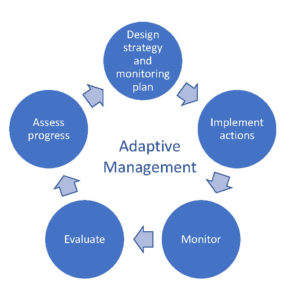 Adaptive Management
Adaptive Management
The District uses an adaptive management approach for its projects. This allows the District to react to changing conditions, while also remaining mindful of the long-term goals for the resource. Adaptive management is an ongoing, systematic approach for natural resource management. It emphasizes identifying and predicting the outcome of management options, implementing management practices, monitoring the outcome(s), and incorporating what is learned into ongoing or future management decisions. The lake management practices considered as part of the Normandale Lake project are part of an adaptive management approach to improving the water quality and ecological health of Normandale Lake.
Project Monitoring
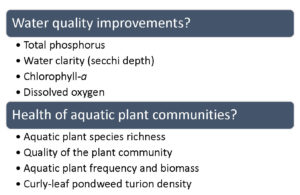
The District is implementing a comprehensive targeted monitoring program to assess the effectiveness of the Normandale Lake Project management activities as they are implemented. This will allow the District to evaluate the ongoing need for additional or repeat management activities. The District will conduct monitoring activities to measure water quality, particularly phosphorus, the health of the aquatic plant communities in Normandale Lake, and to measure the amount of curly-leaf pondweed in the lake.
Monitoring Results
Following the lake drawdown, phosphorous and chlorophyll-a in the lake have decreased while lake clarity has increased. Curly-leaf pondweed populations have decreased; however, an herbicide treatment to manage for curly-leaf pondweed in 2024 was still conducted. With management, native plant populations have thrived with a plant diversity well above state standards.
Water quality monitoring results from 2022: 2022 Water Quality Monitoring Report (pdf)
View additional water quality monitoring reports at: Lake and Creek Monitoring
Visual monitoring
Staff have been routinely monitoring the visual conditions of Normandale Lake since 2021. Click on the monitoring points on the map to view 2022 summer lake conditions.
Questions?
Contact Erica, District Administrator, at 952-358-2276.
